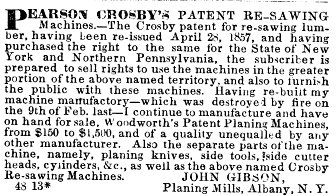John Gibson was one of three wealthy investors who bought most of the rights to Woodworth's planer patents. See the entry under William Woodworth for details of this patent, which was both an important invention and a landmark early example of how the patent system could be abused.

Ad from 1852-05-29 "Scientific American"
Gibson appears to have been the most rapacious in that rapacious group of investors: he reportedly spearheaded the efforts to obtain the 1849 and 1856 patent extension, spending $250,000 each time. The effort to extend the patent beyond 1856 was defeated—in good part due to a campaign led by the publishers of Scientific American—and the syndicate was disbanded immediately thereafter. Gibson then
commissioned a lawyer to badger operators of molders and surfacers for royalties previously unclaimed. His conduct was so odious that Gibson found his Albany plant stuck with a huge inventory of planers which nobody would buy, simply because they were built by Gibson.
(from Chandler W. Jones,
Planers, Matchers and Moulders in America, 1980.)
Gibson attempted to sell licenses to use Pearson Crosby's patent re-sawing machine, which was originally patented in 1842, reissued twice, and extended once. That is a very similar pattern to the Woodworth patent, but Gibson was not nearly so successful with the Pearson patent.

Ad from 1857-08-15 "Scientific American"
In 1858 or shortly thereafter, Gibson sold his business to Daniel Doncaster, who ran it for several years and made a number of improvements to the planers.
Information Sources
- Much of the information here comes from articles in Scientific American in the 1840s and 1850s. These journals are available online through Cornell University's "Making of America" archive.
- Charles Tompkins' 1889 book, A History of the Planing Mill is another excellent source of information on the Woodworth planer cartel, although the book is difficult to find.
- Chandler W. Jones' 1980 book, Planers, Matchers and Moulders in America is another good source of information.
- The March 3, 1858 issue of the Albany Journal had the following notice, which is based on the 1857 Scientific American ad, above, with a paragraph added in the middle:
PEARSON CROSBY'S Patent Re-Sawing Machine
The Crosby patent for resawing Lumber, having been re-issued April 28, 1857, and having purchased the RIGHT to the same for the STATE OF NEW YORK, and Northern PENNSYLVANIA, the subscriber is prepared to sell RIGHTS to use these Machines to the greater portion of the above named territory, and also to furnish the public with these Machines.Having had ten years experience in the use and manufacture of these Machines, I feel confident that the public appreciate them as the only machines worth of the name of a RE-SAWING MACHINE. They are simple in construction, very efficient in operation, and not liable to get out of repair. One of these Small Circular Re-Sawing Machines now in operation in my Mill at ALBANY, sawed 3,400 clapboards, 13 feet long, in ten hours. Largers machines will do more in proportion.
Having rebuilt my MACHINE MANUFACTORY (which was destroyed by fire on the 9th of February last) I continue to manufacture, and have on hand for sale, WOODWORTH'S PATENT PLANING MACHINES from $150 to $1,500, and of a quality unequalled by any other manufacturers. Also, the separate parts of the Machines, namely:—PLANING KNIVES, SIDE TOOLS, SIDE-CUTTER HEADS, CYLINDERS, &c., as well as the above named CROSBY RE-SAWING MACHINES.
The busines of Planing and Re-Sawing Lumber, continued as heretofore. The patronage of the public is respectfully solicited. July 23, 1857.
JOHN GIBSON Planing Mills, corner Water and Spenser streets, and at the Dock, Albany, N. Y.
Thanks to Joel Havens for forwarding the article to us.